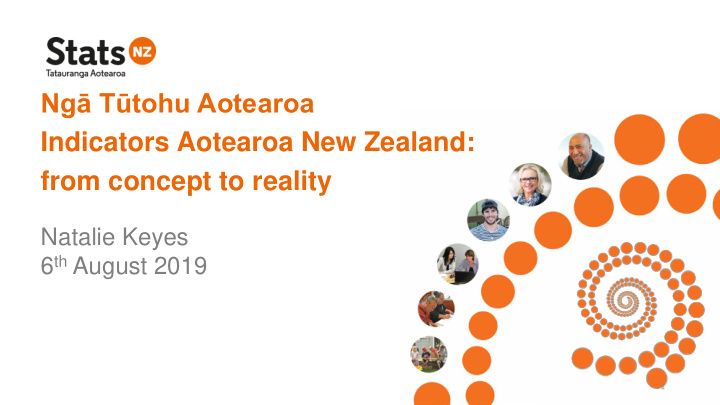



Ngā Tūtohu Aotearoa Indicators Aotearoa New Zealand: from concept to reality Natalie Keyes 6 th August 2019 1
Our vision • To create an independent picture of progress through a wellbeing and sustainable development lens • To move beyond an economic view of progress • To support a wellbeing approach to decision-making • To be inclusive in our design and development process
Informing Government priorities Information, analysis, advice Government Wellbeing decision-making measurement and monitoring Child wellbeing Oranga Tamariki, SIA, DPMC Strategic Ngā Tutohu Environment + other priority-setting Outcome- Aotearoa - MfE, Stats NZ existing key across sectors, based Indicators data and populations frameworks Aotearoa information and policy and reporting Living Standards Framework New Zealand sources levers The Treasury StatsNZ Social reporting Ministry of Social Development
Our process Engage to discover Evaluate Consider to and improve confirm Source and publish
Indicator selection criteria Framework agreed selection Public Engage consultation to discover Technical workshops Indicator selection event Maori Partnership Strategy refresh
Getting started Guiding p principles es Technical c criter eria • Indicators should be outcome focused • Relevant to underlying phenomenon • They should be relevant to New Zealand and incorporate Te Ao Māori • Sensitive to change • Movement should be positively or Statistically sound • negatively associated with progress Able to be disaggregated • • Objective and subjective indicators • Intelligible should be included • Consistent Parsimony should guide selection • process ‘less is more’ • Selection should not be data driven • Indicator set should provide a complete picture
What matters most to New Zealand? 8
An inclusive decision-making process 9
Peer reviews: General Explor e Indigenous Maori Appraisal panel Consider and Government confirm Government Statistician Statistician sign-off consideration Close Project
Data sourcing and processing Website development Source and Website publish launch end of June Ongoing comms and engagement
Results 12
Next steps • Review of framework and indicators from a te ao Māori perspective • Continuous indicator updates Evaluate • Taking feedback on indicators and website to improve
Thanks for listening! • Please visit the website and stay in touch with what we’re up to • Contact us if you’d like to know more • Get in touch to discuss emerging data needs or potential data sources wellbeingindicators.stats.govt.nz indicators@stats.govt.nz
Current w Cu wellbeing Economic standard Subjective wellbeing Health Social connections of living Ability to be yourself Income Health equity Contact with family Experienced wellbeing Income adequacy Health expectancy and friends Mental health status Income inequality Hope for the future Loneliness Low income (psychological distress) Life satisfaction Social support Material wellbeing Amenable mortality Locus of control Net worth Self- reported health Sense of purpose Unpaid work status Whānau wellbeing Child poverty Spiritual health Suicide rate Identity Safety Leisure Culture Domestic violence Language Leisure time Engagement in Experience of development and cultural activities Satisfaction with discrimination retention Intergenerational Harm against children Sense of belonging leisure time transfer of Knowledge injury prevalence Te reo Māori speakers Perceptions of safety/feelings of safety Victimisation 15
Cu Current w wellbeing Cities and Water and Work Knowledge and skills sanitat ion Settlements Core competencies Employment rate Access to natural Hourly earnings (non- cognitive skills) spaces Access to safe water Job satisfaction Early childhood Commuting time to for recreation and food Job strain education (ECE) work Homelessness gathering Not in employment participation Housing affordability Drinking -water quality education, or training Educational attainment Housing quality (NEET) Inequality of Overcrowding Underutilisation educational outcomes Resilience of Unemployment Literacy, numeracy and infrastructure Work/life balance science skills of 15 year Workplace accidents olds Climate Waste Land Governance Costs of extreme Justice equity Material intensity Active stewardship weather events (including recycling, Corruption of land landfill inflows, and Democratic participation second- hand economy) Ecosystems Air quality Institutional trust Waste flows in waterways and coastal Biodiversity/ native Illness attributable to marine environments species air quality 16
Future w wellbeing Financial and physical Natural capital Human capital Social capital capital Cultural ecosystem services Infrastructure Generalised trust Health expectancy Ecological integrity Institutional trust Modified land Literacy, numeracy and Efficiency of land use Volunteering science skills of the adult Net fixed assets Energy consumption population Net international Energy intensity Te reo Māori speakers Energy resources investment position Fish stocks Heritage assets Global CO2 concentrations Productivity Gross greenhouse gas emissions Land assets Levels of pollutants Mineral resources Net greenhouse gas emissions Ocean acidification Productive land Provisioning ecosystem services Quality of water resources Regulating ecosystem services Renewable energy Soil health Stock of fresh water resources 17 Waste generation
Impact ct on on th the r res est o t of th the w e wor orld ld Financial and Human capital Natural capital physical capital Foreign direct Net greenhouse Net migration by investment gas emissions skill type International investment position Economic standard Climate Waste of living Official Consumption of net Export of waste (net development greenhouse gas and gross) assistance emissions Remittances to other countries 18
Contextual i indicators Population Production Age and sex structure Components of final use Disability status National income Ethnic composition Production by industry Family composition Regional production Fertility Returns for factors of production Geographic distribution Total New Zealand production Household composition Migration Overseas- born population Population size and growth Sexual identity Sexual orientation Urban/rural distribution 19
20
Recommend
More recommend